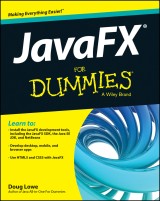Details

JavaFX For Dummies
1. Aufl.
|
20,99 € |
|
| Verlag: | Wiley |
| Format: | |
| Veröffentl.: | 24.09.2014 |
| ISBN/EAN: | 9781118421666 |
| Sprache: | englisch |
| Anzahl Seiten: | 432 |
DRM-geschütztes eBook, Sie benötigen z.B. Adobe Digital Editions und eine Adobe ID zum Lesen.
Beschreibungen
<b>Unleash the power of JavaFX for a wide range of devices</b> <p><i>JavaFX For Dummies</i> gives you access to an innovative software platform that allows you to create and deliver rich Internet applications that can run across a wide variety of connected devices. This accessible book highlights the most important features of this powerful graphics platform, giving you the tools to understand it quickly and easily! No experience with JavaFX? No problem. <i>JavaFX For Dummies</i> has been written especially for newbies and it also serves as a great reference resource for more experienced Java developers.</p> <p>Author Doug Lowe has been writing programming books for decades, and he brings his experience and passion to this guide, sharing his expert approach to coding using JavaFX. The book shows you how to work with JavaFX controls, how to enhance your scenic design, and also offers advice on how to make a splash with your programs. Then, the author wraps it all up with extra recommendations and resources to guide you as you move forward.</p> <ul> <li>Helps developers quickly learn to take advantage of JavaFX's lightweight, high-performance platform</li> <li>Highlights essential JavaFX features for simple coding that can be rolled out across multiple devices</li> <li>Instructs readers on methods for creating compelling, visually appealing applications</li> <li>Includes recommendations and resources for honing your JavaFX skills</li> </ul> <p>With <i>JavaFX For Dummies</i>, you'll be on your way to easier, more efficient coding for a variety of connected devices.</p>
<p>Introduction 1</p> <p>About This Book 1</p> <p>Foolish Assumptions 2</p> <p>How This Book Is Organized 3</p> <p>Part I: Getting Started with JavaFX 3</p> <p>Part II: JavaFX Controls 3</p> <p>Part III: Enhancing Your Scenic Design 3</p> <p>Part IV: Making Your Programs Come Alive 4</p> <p>Part V: The Part of Tens 4</p> <p>Icons Used in This Book 4</p> <p>Beyond the Book 5</p> <p>Where to Go from Here 5</p> <p><b>Part I: Getting Started with JavaFX 7</b></p> <p>Chapter 1: Hello, JavaFX! 9</p> <p>Chapter 2: Looking Closer at JavaFX Programming 31</p> <p>Chapter 3: Handling Events 49</p> <p>Chapter 4: Setting the Stage and Scene Layout 67</p> <p>Chapter 5: Using Layout Panes to Arrange Your Scenes 93</p> <p>Chapter 6: Getting Input from the User 117</p> <p><b>Part II: JavaFX Controls 141</b></p> <p>Chapter 7: Introducing the JavaFX Node Hierarchy 143</p> <p>Chapter 8: Choosing from a List 155</p> <p>Chapter 9: Working with Tables 185</p> <p>Chapter 10: Making Menus 209</p> <p><b>Part III: Enhancing Your Scenic Design 225</b></p> <p>Chapter 11: More about Layout Panes for Precise Scene Design 227</p> <p>Chapter 12: Skinning Your Application with CSS 255</p> <p>Chapter 13: Drawing Shapes 267</p> <p>Chapter 14: Adding Special Effects 289</p> <p><b>Part IV: Making Your Programs Come Alive 307</b></p> <p>Chapter 15: Using Properties to Create Dynamic Scenes 309</p> <p>Chapter 16: Using Images and Media 327</p> <p>Chapter 17: Animating Your Scenes 341</p> <p>Chapter 18: Targeting Touch Devices 365</p> <p><b>Part V: The Part of Tens 375</b></p> <p>Chapter 19: Ten More JavaFX Controls 377</p> <p>Chapter 20: Ten Steps to Building a 3D World 389</p> <p>Index 407</p>
<p><b>Doug Lowe</b> has been writing computer programming books since the guys who invented Java were in high school. Lowe has written books on a wide variety of topics and is the bestselling author of more than 30 <i>For Dummies</i> books, including all editions of <i>Java All-In-One For D</i>ummies.</p>
<p><b><i>Learn to:</i></b></p> <ul> <li>Install the JavaFX development tools, including the JavaFX SDK, the Java SE JDK, and NetBeans</li> <li>Develop desktop, mobile, and browser apps</li> <li>Use HTML5 and CSS3 with JavaFX</li> </ul> <p><b>The fast and easy way to unleash the power of JavaFX</b></p> <p>No experience with JavaFX? No problem! This hands-on guide highlights the most important features of this powerful graphics platform, giving you the tools to understand it quickly and easily. You’ll find out how to work with JavaFX controls, enhance your scenic design, and create more efficient coding for a variety of connected devices.</p> <ul> <li>Hello, JavaFX! — peruse the possibilities of JavaFX, take a look at a simple JavaFX program, download and install JavaFX, and get familiar with the Click Me program</li> <li>All the world’s a stage — find out how to set the stage and scene layout, use layout panes to arrange your scenes, create a dialog box and close button, and get input from the user</li> <li>Take the reigns — get familiar with the JavaFX node hierarchy, choose from a list, work with tables, and make menus</li> <li>Growing panes — discover more about layout panes for precise scene design and start drawing shapes and adding special effects like a JavaFX pro</li> <li>Do it dynamically — use properties, images, and media to create dynamic scenes, and get the know-how to animate your scenes and target touch devices</li> </ul> <p><b>Open the book and find:</b></p> <ul> <li>How to import JavaFX packages</li> <li>Tips on implementing the event handler interface</li> <li>Ways to draw transparently and use a gradient fill</li> <li>Instruction on adding shadows and creating reflections</li> <li>How to work with audio and video files</li> <li>The lowdown on gestures and touch events</li> <li>Links to a handy cheatsheet and cool extras</li> </ul>
Diese Produkte könnten Sie auch interessieren:

Pattern-Oriented Software Architecture, Patterns for Resource Management

von: Michael Kircher, Prashant Jain

33,99 €















